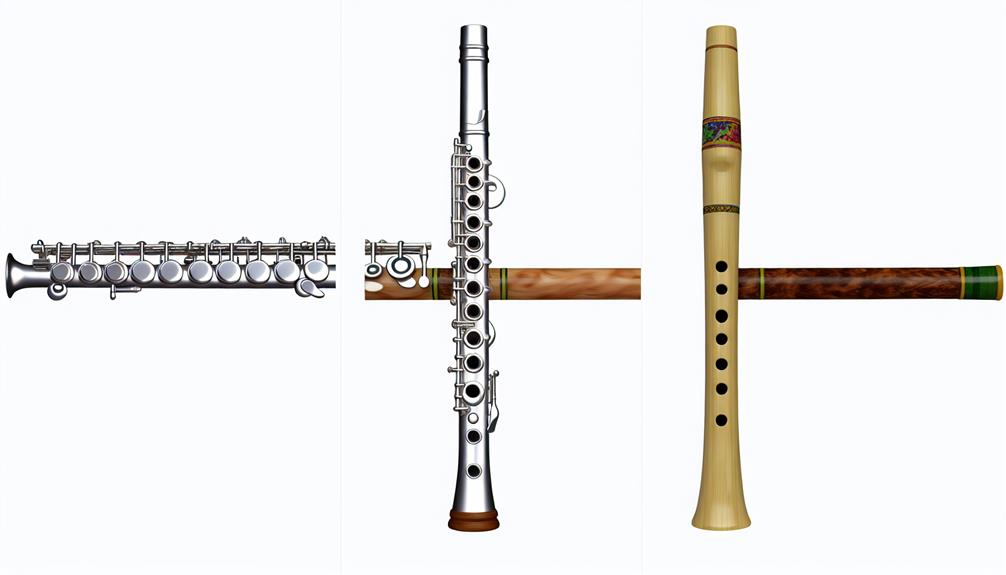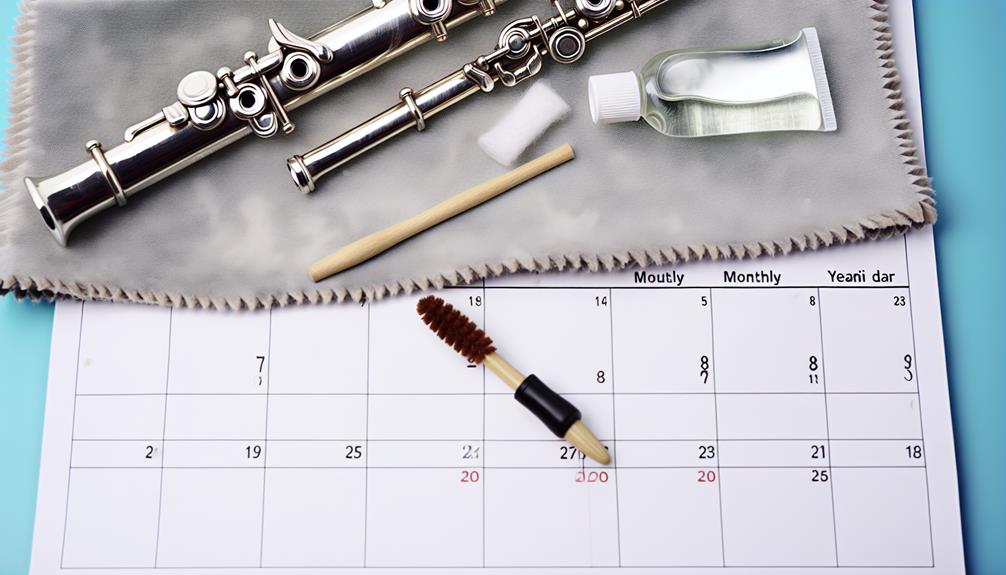Flutists, like all musicians, understand the importance of a solid warm-up routine to set the stage for a successful practice or performance. However, selecting the most effective warm-up exercises can be a nuanced process that requires consideration of various factors. From breathing techniques to finger exercises, each element plays a crucial role in preparing the flutist for the demands of playing. By exploring the best warm-up routines tailored specifically for flutists, one can uncover a wealth of strategies to optimize their playing abilities and unlock their full potential.
Key Takeaways
- Focus on diaphragm control for efficient breath support.
- Incorporate lip slurs to improve embouchure strength and flexibility.
- Practice scales and arpeggios for technique, intonation, and tone.
- Engage in long tones to enhance breath control and tone consistency.
- Include articulation drills and finger exercises for precision and dexterity.
Breathing Exercises
Begin your warm-up routine with essential breathing exercises to optimize your flute playing performance. Proper diaphragm control is crucial for producing a rich, resonant tone while playing the flute. Before you even pick up your instrument, take a few moments to focus on your breathing. Sit or stand up straight, close your eyes, and take a deep breath in through your nose, allowing your diaphragm to fully expand. Then, exhale slowly and completely through your mouth, engaging your diaphragm to push out all the air. Repeat this several times to center yourself and prepare your body for playing.
Relaxation techniques can greatly benefit your breathing exercises and overall flute performance. Tension in your body can restrict airflow and hinder your ability to play with ease. As you focus on your breathing, pay attention to any areas of tension in your body, such as your shoulders, neck, or jaw. Practice releasing this tension with gentle stretches or massage. Incorporating relaxation techniques into your warm-up routine can help you achieve a more effortless and controlled airflow while playing the flute.
Lip Slurs
To enhance your flute playing technique and flexibility, incorporating lip slurs into your warm-up routine is essential. Lip slurs are a fundamental exercise for flutists that provide a myriad of benefits, including enhancing embouchure control, building essential muscles, expanding your range, and training flexibility.
Embouchure control is crucial for producing a clear and resonant tone on the flute. Lip slurs help strengthen the muscles around the mouth and lips, improving your ability to manipulate your embouchure for different notes and dynamics. By practicing lip slurs regularly, you can develop the precision and finesse needed for advanced flute playing.
Additionally, lip slurs are excellent for muscle building, especially in the facial muscles involved in flute playing. Regular practice of lip slurs can help prevent fatigue during long playing sessions and reduce the risk of injuries related to overworked muscles.
Moreover, lip slurs aid in range expansion and flexibility training. As you navigate through various intervals smoothly in a lip slur exercise, you are not only increasing your range but also training your muscles to move efficiently between notes. This is essential for playing challenging passages with ease and fluidity.
Incorporating lip slurs into your warm-up routine will not only improve your technique but also enhance your overall playing experience. Practice diligently, and you will reap the rewards of improved embouchure control, muscle strength, expanded range, and enhanced flexibility.
Scales and Arpeggios
Building upon the foundation laid by practicing lip slurs, flutists can further enhance their technical proficiency and musical expression by incorporating scales and arpeggios into their warm-up routines. Scales are fundamental to developing a flutist's technique, as they help in mastering fingerings, intonation, and breath control. Arpeggios, on the other hand, are essential for building a flutist's ability to navigate through different chord progressions with fluidity and grace.
When practicing scales and arpeggios, flutists have the opportunity to not only improve their technical skills but also to work on their tone development. Focusing on producing a warm, resonant tone while playing scales and arpeggios can significantly impact the overall sound quality of a flutist. Additionally, incorporating improvisation techniques into scale practice can help flutists become more versatile musicians, enabling them to express themselves freely and creatively.
To make the most of scale and arpeggio practice, flutists should vary the tempo, dynamics, and articulation to challenge themselves and keep the warm-up routine engaging. By paying attention to detail and striving for precision in each note, flutists can refine their playing and set a strong foundation for their practice sessions and performances.
Long Tones
Developing a consistent and resonant tone is crucial for flutists, and one effective way to achieve this is through dedicated practice of long tones. Long tones are fundamental exercises that focus on sustaining a single note for an extended period, allowing the musician to concentrate on tone quality, consistency, and intonation. By holding a note for an extended duration, flutists can fine-tune their embouchure, breath control, and air support, leading to a more stable and beautiful sound.
To begin a long tone exercise, choose a comfortable pitch within your range and play it with a full, supported sound. Focus on using steady air support and maintaining a constant airflow throughout the duration of the note. Pay attention to any fluctuations in tone and work to eliminate them by adjusting your embouchure and airspeed. As you progress, challenge yourself to play longer notes, gradually increasing the duration to build endurance and control.
Long tones not only help improve tone quality and consistency but also enhance overall breath control and stability. Practicing these exercises regularly can lead to a more controlled and expressive sound, making them an essential part of every flutist's warm-up routine. Remember, the key to mastering long tones lies in patience, focus, and a commitment to refining your air support and control.
Articulation Drills
Exploring the nuances of articulation through targeted drills is a valuable practice for flutists seeking to refine their musical expression and technical proficiency. To enhance your articulation skills, incorporating tongue exercises into your warm-up routine can make a significant difference. These exercises help in developing clarity, precision, and control in your playing. One effective exercise is practicing single tonguing on scales or arpeggios at varying tempos, focusing on maintaining evenness and consistency in articulation.
In addition to traditional tonguing exercises, flutists can benefit from incorporating musical phrasing into their articulation drills. By emphasizing different articulations within a phrase, you can bring out the musicality of the passage and add depth to your interpretation. Practice playing the same passage with various articulation patterns to explore different expressive possibilities. This not only enhances your technical skills but also allows you to convey emotions and musical ideas more effectively.
Finger Exercises
To improve dexterity and coordination, flutists can incorporate finger exercises into their warm-up routines. Finger dexterity is crucial for playing the flute effectively, as it allows for faster and more accurate finger movements on the keys. Hand coordination is also essential, as it ensures that all fingers work together smoothly to produce the desired notes.
One effective way to enhance finger dexterity and hand coordination is by practicing specific exercises designed to target these areas. Here is a table outlining three beneficial finger exercises for flutists:
| Exercise | Description | Duration |
|---|---|---|
| Finger Lifts | Lift each finger sequentially off the keys, focusing on precision and control. | 2 minutes |
| Chromatic Scale Runs | Play chromatic scales slowly, paying attention to evenness and clarity in each note. | 5 minutes |
| Finger Flexibility | Hold each finger down on the keys while lifting the others, promoting independence and strength. | 3 minutes |
Incorporating these finger exercises into your warm-up routine can help you enhance your finger dexterity and hand coordination, leading to improved overall performance on the flute. Remember to start slowly and gradually increase speed and complexity as your skills develop. By dedicating time to these exercises regularly, you will notice significant progress in your playing abilities.
Body Stretches
Incorporating body stretches into your warm-up routine is essential for maintaining flexibility and preventing tension as a flutist. Flexibility exercises play a crucial role in preparing your body for the demands of playing the flute. Start your routine with gentle stretches that focus on areas like the neck, shoulders, arms, and back. These exercises help loosen up tight muscles and improve your range of motion, allowing you to play more comfortably and expressively.
Relaxation techniques are also beneficial during your warm-up. Deep breathing exercises can help calm your mind and relax your body, setting a positive tone for your practice session. As you stretch, focus on your breath, inhaling deeply and exhaling slowly to release any tension you may be holding onto.
Posture alignment is another key aspect of body stretches for flutists. Proper posture not only enhances your playing but also prevents injuries in the long run. Pay attention to your alignment as you stretch, keeping your spine straight and shoulders relaxed. Engage in muscle release exercises to target areas of tension, such as the upper back and shoulders, to promote a more fluid and effortless playing experience.
Frequently Asked Questions
How Can I Prevent Hand Cramps While Playing the Flute?
Hand cramps while playing the flute can be prevented by incorporating hand stretches and finger exercises into your warm-up routine. Regularly stretching and strengthening the muscles in your hands and fingers can help improve flexibility and reduce the likelihood of cramps.
Additionally, maintaining proper hand position and posture while playing can also help alleviate tension and prevent cramping. Remember to listen to your body and take breaks when needed to avoid overexertion.
Are There Specific Warm-Ups for Improving Tone in High Registers?
To enhance your tone in high registers and fortify your embouchure, consider incorporating warm-up exercises that specifically target these areas. Implementing tailored routines that focus on expanding and strengthening the muscles involved in producing high notes can help refine your sound quality and control.
Can Warm-Up Routines Help With Reducing Performance Anxiety?
Warm-up routines can definitely aid in reducing performance anxiety. Incorporating mindfulness exercises, relaxation techniques, visualization, and positive affirmations into your warm-up routine can help calm nerves and boost confidence.
Is There a Warm-Up Routine That Targets Vibrato Technique?
When targeting vibrato technique in warm-up routines, incorporating specific exercises can be highly beneficial.
Vibrato exercises, such as slow oscillations in pitch paired with breath control, can help flutists develop and refine this expressive technique.
Additionally, focusing on finger flexibility through scales and arpeggios can further enhance the overall vibrato effect.
What Warm-Ups Are Recommended for Enhancing Breath Control in Fast Passages?
To enhance breath control in fast passages, flutists can benefit from warm-up routines that focus on breath support and articulation techniques.
Incorporating exercises like long tones, intervallic scales, and articulation exercises can help strengthen the respiratory muscles and improve the coordination needed for precise and controlled playing in rapid passages.
Consistent practice of these warm-ups can lead to increased stamina and control, ultimately enhancing performance quality.
Conclusion
Incorporating a variety of warm-up routines into your practice sessions can greatly benefit your flute performance. By focusing on breathing exercises, technique enhancement exercises, and physical preparation, you can improve your breath support, tone quality, and overall control.
Remember, the best warm-up routines for flutists are essential for preparing your mind and body to play with fluidity and precision. So, embrace these routines like a warm hug from your favorite musician and watch your playing soar to new heights!





